|
|
|
Sort Order |
|
|
|
Items / Page
|
|
|
|
|
|
|
| Srl | Item |
| 1 |
ID:
111892
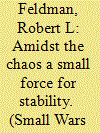

|
|
|
|
|
| Publication |
2012.
|
| Summary/Abstract |
Though parts of Somalia appear mired in intractable conflict, both domestic and foreign trade continues. As a result amidst the conflict, corruption, and chaos Somalia's business community is a small force for peace and stability. Thus, efforts directed at enhancing the business community, possibly via the Transitional Federal Government or its successor, could play a small role in improving the situation in this strategically poised country with a very entrepreneurial population. However, such success is far from certain, and numerous other factors besides a strengthened business community would have to occur for Somalia even to begin the journey on the long road to recovery.
|
|
|
|
|
|
|
|
|
|
|
|
|
|
|
|
| 2 |
ID:
111890


|
|
|
|
|
| Publication |
2012.
|
| Summary/Abstract |
Theories and counterinsurgency doctrines emphasize the importance of avoiding civilian casualties. Yet, many operations produce large numbers of so-called collateral civilian deaths. I present two competing arguments for when collateral deaths occur. One the one hand, they could be the unintentional result of offensives when trying to maintain force protection; on the other hand, they could be the result of a deliberate choice of relying on indiscriminate violence when pressured on the battlefield. I use new data on violence in Afghanistan 2004-2009, disaggregated by province and month, to examine what type of battlefield dynamics are more likely to produce high levels of collateral civilian casualties. The results show that civilian casualties are particularly high after counterinsurgency forces suffer losses in combat.
|
|
|
|
|
|
|
|
|
|
|
|
|
|
|
|
| 3 |
ID:
111895
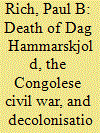

|
|
|
| 4 |
ID:
111889
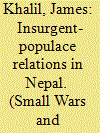

|
|
|
|
|
| Publication |
2012.
|
| Summary/Abstract |
The first objective of this article is to provide conceptual clarity regarding the term 'support' in the context of insurgent campaigns. While it is commonly claimed that insurgent and counterinsurgent forces compete for the support of the populace, there is often ambiguity as to whether this refers to a voluntary preference for a group of armed actors (attitudinal support), or a set of actions that provide direct benefits to one of these groups (behavioural support or collaboration). Furthermore, while a number of academics and practitioners focus upon the former on the assumption that it translates into the latter with sufficient consistency (Lawrence 'of Arabia', Mao, etc.), others maintain a contradictory stance (Kilcullen, Kalyvas, etc.). The findings from research undertaken into the 1996-2006 conflict in Nepal suggest a more complex reality in that certain forms of collaboration (e.g. provisions of information) seemingly necessitate supportive attitudes to a greater extent than others (e.g. supplies of food). The second objective is to evaluate the various approaches used by the Maoist insurgents to generate these distinct forms of support. While their ideology largely failed to resonate with the populace, attitudinal support was obtained through various 'popular appeals', including land reform, an opposition to an increasingly repressive monarchy, and campaigns to empower certain marginalised sectors of society. In contrast, the development initiatives of the Maoists, and their nationalist rhetoric in opposition to US and Indian influence were substantially less effective. Each of these initiatives were undertaken to obtain collaboration via attitudinal support, but the former was also generated directly through the use of coercion against specific non-combatants.
|
|
|
|
|
|
|
|
|
|
|
|
|
|
|
|
| 5 |
ID:
111888
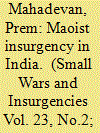

|
|
|
|
|
| Publication |
2012.
|
| Summary/Abstract |
Since 2004, the Indian government has described the country's Maoist insurgency as a grave threat to domestic security. A study of the sustaining dynamics behind Maoist violence suggests that the rebels are growing operationally stronger due to profits derived from organized crime. Having built up a parasitic economy that operates within the boundaries of nominal state control, they are proceeding to undermine that same control. In effect, the Maoists have assumed characteristics of a Mafia group. With India's economic growth having surged in recent years, their ability to finance aggressive operations and consolidate their subversive infrastructure has increased correspondingly.
|
|
|
|
|
|
|
|
|
|
|
|
|
|
|
|
| 6 |
ID:
111891
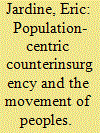

|
|
|
|
|
| Publication |
2012.
|
| Summary/Abstract |
The theory of population-centric counterinsurgency rests upon the untenable premise that the population within a theater of operations is fixed in place. By showing that people tend to move away from contested rural areas towards the relative safety and prosperity of counterinsurgent-controlled areas, this article demonstrates that this crucial premise is empirically false. Furthermore, a theory of counterinsurgent resource deployment, population movement, and incumbent strategic ineffectiveness is presented. Ultimately, the application of counterinsurgency resources actually dislocates the population from their place of residence and causes them to move into cities. When the urban areas' ability to absorb newcomers is overwhelmed, localized negative externalities emerge and can give rise to crime and insecurity. Such increased insecurity then creates an incentive for the counterinsurgency to retrench its resource use into the cities. As more physical territory is conceded to the insurgency, the relative strategic effectiveness of the counterinsurgency declines.
|
|
|
|
|
|
|
|
|
|
|
|
|
|
|
|
| 7 |
ID:
111893


|
|
|
|
|
| Publication |
2012.
|
| Summary/Abstract |
Israel and Hezbollah have applied the lessons learned from the 2006 Lebanon War and have been preparing for a future conflict with both sides aiming for a more decisive victory. With improved capabilities from 2006, future hostilities will be far more destructive. This article analyzes their performance in 2006 and the lessons they have drawn to predict what a future conflict is likely to look like. The article analyzes both parties in three categories: ground forces; rockets, missiles, and anti-armor weapons; and lastly, Israel's air and sea dominance and Hezbollah's efforts to counter that dominance. Finally, this article argues that, contrary to conventional wisdom, a large-scale conflict between Israel and Hezbollah is unlikely to become a larger regional conflict involving Syria and Iran.
|
|
|
|
|
|
|
|
|
|
|
|
|
|
|
|
| 8 |
ID:
111894
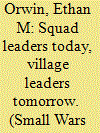

|
|
|
|
|
| Publication |
2012.
|
| Summary/Abstract |
From 1956 to 1960, the French Army developed a force of Muslim auxiliaries (supplétifs) as a major component of its strategy to combat the National Liberation Front (FLN) insurgency in Algeria. Aside from their military utility in hunting down the guerrillas in the mountains and forests, the supplétifs were instrumental in undermining FLN legitimacy in the countryside. The rapid growth and employment of the supplétif force dismantled FLN political control in the villages, undermined the enemy's unity, and critically weakened the revolutionaries' claim to represent all of Algeria's Muslims. The military and political activities of France's Muslim soldiers also projected an image of Muslim-European unity behind the French cause, and portrayed the French Army as the only legitimate political force in numerous villages. These political successes, however, were limited to the local, tactical level of revolutionary warfare, and the Army was never able to convert the supplétifs into a force of decisive, strategic political significance. They thus had little ultimate impact on the outcome of the conflict.
|
|
|
|
|
|
|
|
|
|
|
|
|
|
|
|
|
|
|
|
|